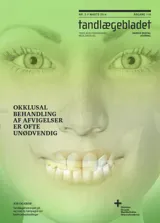Osteoradionekrose i mandiblen med patologisk fraktur
Baggrund – Osteoradionekrose er en alvorlig komplikation til strålebehandling i hoved-hals-regionen, der kan føre til ansigtsdeformitet, smerte, sekvestrering af nekrotisk knogle, ekstraorale fistler og patologiske frakturer. Flere faktorer prædisponerer for udviklingen af osteoradionekrose: stråledosis, lokalisation af tumor, resektion af knogle i forbindelse med tumorkirurgi, brug af alkohol, tobak og dårlig ernæringstilstand samt dårlig mundhygiejne, dårlig tandstatus, dårlig tilpasning af proteser, kirurgisk traume, heriblandt tandekstraktion. Patienttilfælde – I nærværende artikel præsenteres en 60-årig kvinde med en patologisk mandibelfraktur opstået efter ekstraktion af tænder i underkæben på grund af osteoradionekrose. Prædisponerende faktorer for udviklingen af osteoradionekrose diskuteres. Konklusion – Kirurgisk traume er den hyppigste årsag til udvikling af osteoradionekrose. Derfor bør kirurgiske indgreb på patienter, som tidligere er strålebehandlet i hoved-hals-regionen, så vidt muligt undgås. En bedre forståelse af risikofaktorer kan forbedre vores evne til at forhindre, at patienter udvikler osteo- radionekrose.
Pathological fracture of the mandible: Background – Osteoradionecrosis is a serious complication of radiotherapy that often leads to severe facial deformity, pain, sequestration of devitalized bone, orocutaneous fistulas and pathological fracture. Many factors have been considered regarding predisposition to the development of osteoradionecrosis. These include radiation dose, tumour location, resection of the mandible during surgical therapy of the tumour, lack of oral hygiene, poor condition of the teeth, poor adjustment of dentures, trauma including teeth extractions, use of alcohol and tobacco and poor nutritional status. Case study – The case is presented of a 60-year-old woman with a pathological fracture of the mandible due to osteoradionecrosis occurring after extraction of teeth. Considerations regarding risk factors of osteoradionecrosis are discussed. Conclusion – Surgical intervention in patients who have received radiotherapy is highly correlated with osteoradionecrosis of the jawbone. Therefore, a more conservative approach is recommended. A better understanding of risk factors for the development of osteoradionecrosis may improve our ability to prevent this complication.


